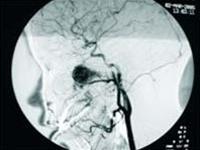Detection and treatment of nasopharyngeal fibroids
Nasopharyngeal fibroids are a benign tumor but are capable of spreading widely, destroying strong bones, degrading health and danger to patients' lives if not detected and treated promptly.
 Image of nasopharyngeal vascular fibrosis (Photo: TTO) In the past, people with nasopharyngeal fibroids were described with a terrible face like eyeballs protruding from the eye sockets, the nose was wide, cheeks bulging like stones pebbles. Today we no longer see such a serious level because the disease has been detected earlier.
Image of nasopharyngeal vascular fibrosis (Photo: TTO) In the past, people with nasopharyngeal fibroids were described with a terrible face like eyeballs protruding from the eye sockets, the nose was wide, cheeks bulging like stones pebbles. Today we no longer see such a serious level because the disease has been detected earlier.
Nasopharyngeal fibrosis is a common disease in puberty, common in men, aged 15-25 in rural areas. It is thought that the development of nasopharyngeal fibroids is related to endocrine at puberty.
Fibroids adhere to the skull base of the nasopharynx and spleen into adjacent structures to create the legs that attach to the sieve area, the back of the nose, the wings in the butterfly's legs. The tumor is firm, has many lobes, and stalks. The size is small and small depending on the time when the disease appears until the surgery to remove the tumor. Taking the tumor to be observed under a microscope will see a lot of blood vessels or scattered blood pools in the tumor that organize the fibers and form a submucosal network that covers the entire tumor.
Evolution of the disease
The disease is silently evident with the expression of one-sided nasal congestion is increasing, the late stage of stuffy nose is blocked on both sides. Continuous runny nose, increasing gradually with two wet and mucus-filled nostrils. Occasionally, nosebleeds, initially capable of holding, after having intervention of medical facilities to hold blood from the nose. Accompanying these symptoms are tinnitus and hearing loss due to the tumor squeezing the ear canal area. The patient is thin and tired.
Examining the nasal cavity see the pink tumor lying on the back of the nose, when large growth fills the nasal cavity, the tumor is pushed up to narrow the opposite side of the nasal cavity. A throat examination and a back-nose examination showed a bulging screen, pushed forward and below or too loudly to the throat. Gentle touch whether the tumor is hard or soft, big or small, mobile.
If to develop naturally the tumor will fill the nasal cavity, jaw sinus, sinus sinus, eye sockets, break down the jaw, pepper the upper jaw and float under the skin. Tumors that enter the intracranial, intracranial nerve damage blind the eyes, difficulty swallowing, cannot smell. Patients with untreated nasopharyngeal tumors will die from bleeding and intracranial complications that increase brain pressure.
A definitive diagnosis is made through a clinical examination: a pink tumor, which appears at the back of the male patient aged 15-25, has a nosebleed that needs to be sent to the ENT clinic. for a CT scan. Scanner and vein capture to make the right decision.
Management of disease
Surgery is the main treatment, if it is detected early that the tumor can be removed through the endoscopy, this line does not leave a scar on the nose like surgery with a large tumor. In case the tumor is too big, it is no longer indicated that surgery may indicate radiation beams combined with hormones to help shrink the tumor.
- Many women have fibroids without knowing it
- New breakthrough in treatment of throat cancer
- Uterine fibroids are fatal to the fetus
- Essential knowledge about throat cancer
- Beware of back pain
- Unexpected cause of throat cancer you have to know
- The risk of nasopharyngeal cancer when eating a lot of salted fish
- Detection of breast cancer using mine detection technology
- Trial of treating cystic fibrosis on ... pigs
- Method or treatment of rhinitis, throat
- Prospects for early detection of cancer by bioelectric signals
- With just 3 fingers, you can check yourself if you are at risk of cancer or not
 Green tea cleans teeth better than mouthwash?
Green tea cleans teeth better than mouthwash? Death kiss: This is why you should not let anyone kiss your baby's lips
Death kiss: This is why you should not let anyone kiss your baby's lips What is salmonellosis?
What is salmonellosis? Caution should be exercised when using aloe vera through eating and drinking
Caution should be exercised when using aloe vera through eating and drinking